#Short Range Cruise Missiles
Text
ISRAEL REALTIME - "Connecting the World to Israel in Realtime"
Sundown - Nov 22
🔻CRUISE MISSILE from YEMEN… at Eilat - shot down by fighter jet!
🔻ROCKETS & MORTARS from LEBANON… Hanita, multiple rounds, Yaftach, Malkiya area.
🔻ROCKETS from GAZA… short range, Gaza area towns.
🔸CEASEFIRE… starts tomorrow at 10:00 AM, maybe (2 official sources say, 1 official source says no time yet agreed). Hezbollah has stated they also will follow the ceasefire if Israel does - there is no such agreement. A source in Hezbollah told Al Jazeera: "Hezbollah will be committed to the ceasefire announced if Israel is. Any Israeli escalation in southern Lebanon or Gaza during the ceasefire - will be met with Hezbollah's response”.
🔸DEAL DETAILS… Hamas says: As part of the deal, about 200-300 aid trucks will enter the Strip, including 8 fuel tankers. The aid will be distributed in the south of the Gaza Strip as well as in the north. They also added the recovery of the bodies from underneath the ruins of the buildings was a significant motive in reaching the agreement. (( We cynically add, recovery of access to underground armaments needed. )) Prime Minister Netanyahu is expected to hold a press conference this evening where he will explain to the public the deal reached.
◾️4TH DEAD HOSTAGE… Shani Gabai, hy”m, was identified from the bodies found at Shifa hospital. Family and friends reported that her last contact was on the morning of the murderous massacre, when she said she had been shot in the leg and had a tourniquet.
◾️SYRIA REPORTS… (enemy official media) Site near Damascus attacked by 2 missiles from Israel.
◾️IDF ATTACKS LEBANON… The IDF says several rockets fired from Lebanon at the northern communities of Netu’a, Zar’it and Yiftah. All landed in open areas. Responding with artillery, and tanks shelled a Hezbollah observation post. (Enemy sources) IDF is attacking from the air in Khiam and in the Qlayaa area. (Shiite sources) an Israeli attack now in the area of Sayeda Zeinab (Iranian stronghold) in southern Damascus, hitting and destroying “a building”.
◾️IDF RETURNS… bodies taken from Shifa hospital, after confirming that “only” 3 were Israeli hostage bodies.
◾️TUNNEL COUNT… IDF spokesman: Ya'halom fighters have so far destroyed 400 tunnel shafts in the Gaza Strip. (( Want to know where all the reconstruction concrete went? ))
◾️IRAQ YELLS AT U.S. FOR DEFENDING ITSELF… The Iraqi government: the American attacks within our territory constitute a clear violation of the mission of the American army in the country as part of the coalition against ISIS.
24 notes
·
View notes
Text

IMAGES: B-52 Stratofortress lands in South Korea for the first time
Fernando Valduga By Fernando Valduga 10/17/2023 - 08:35am Military
The U.S. Air Force is celebrating the 70º anniversary of the U.S.-South Korea alliance with a huge demonstration of air power at the 2023 Seoul International Aerospace and Defense Exhibition (ADEX) this week, and a B-52H Stratofortress made a full landing on the Korean Peninsula for the first time today, according to all known reports.
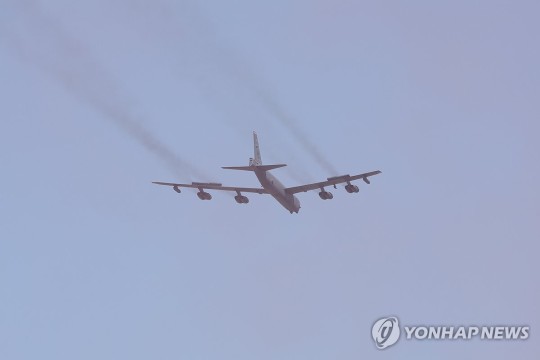
Also during the exhibition, scheduled from October 17 to 22 at Seoul Air Base, USAF will exhibit eight other types of aircraft through static displays and aerial demonstrations, according to the Pacific Air Forces, including: F-22 Raptor, F-16 Fighting Falcon, A-10 Thunderbolt II, C-17 Globemaster III, C-5 Galaxy, KC-135 Stratotanker, U-2 Dragon Lady and E-3 Sentry. Other U.S. military aircraft include CH-47F Chinook, AH-64 Apache, F-35B Lightning II and E/A-18 Growler.

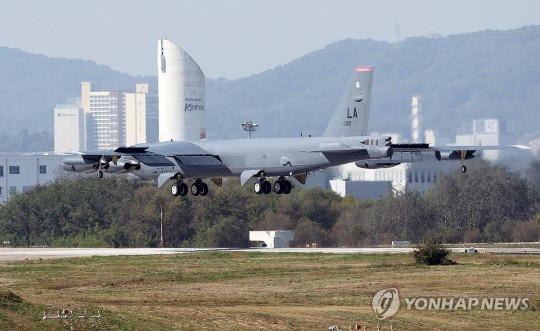
The famous nuclear-capable B-52 bomber carried out two overflights at the event before landing at Cheongju Airport, 140 km south of Seoul.
“These overflights, air demonstrations and static displays, including the landing of the B-52 on the peninsula, are part of our ongoing commitment to promote peace, stability and prosperity on the Korean peninsula,” Major Rachel Buitrago, director of Public Affairs of the 7ª Air Force, said in a statement.

The B-52 Stratofortress, known as BUFF, is the main cruise missile carrier of the U.S. Air Force. The H model is now the last variant of the Stratofortress, which has been in service since the 1950s.
Although the B-52 has never landed in Korea, it has carried out several recent exercises near or over the Korean Peninsula. On June 30, several B-52s from Barksdale Air Base, along with South Korean F-16, F-15E and F-35As and KF-16, conducted a joint overflight of the country.
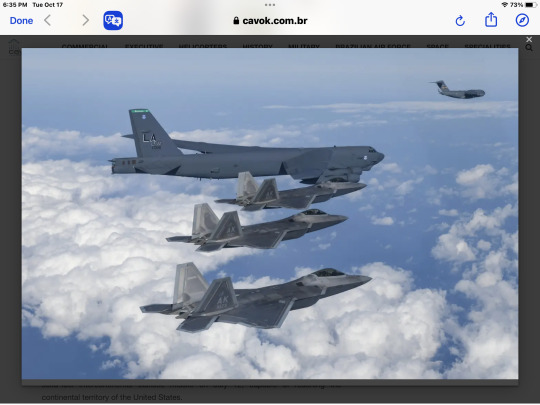
Then, on July 13, the long-range bomber was accompanied by F-16 and three F-15K aircraft of the Republic of Korea Air Force (ROKAF) for a combined air training session over the peninsula. This exercise followed North Korea's allegations that it launched a solid-fuel intercontinental ballistic missile on July 12, capable of reaching the continental territory of the United States.
North Korea continued to carry out numerous missile launches this year, including the most recent test in September, when it fired two short-range ballistic missiles into the sea off the eastern coast.

“We still face ongoing challenges from North Korea, including its dangerous and destabilizing missile testing program, and others that would undermine the rules-based international order,” Defense Secretary Lloyd Austin said in April when he welcomed South Korean President Yoon Suk Yeol who was visiting the Pentagon.
Austin and President Joe Biden pledged to intensify joint military exercises between the U.S. and South Korea, including those with nuclear-capable resources, such as strategic bombers or submarines with ballistic missiles. Last week, the aircraft carrier USS Ronald Reagan made a stopover in Busan, South Korea.

“2023 marks 70 years of alliance between the United States and the Republic of Korea - an alliance that has proved to be solid in the face of challenges over many decades. It is among the most interoperable, capable and dynamic bilateral alliances in the world," Lieutenant General Scott Pleus, commander of the Seventh Air Force and deputy commander of the U.S. Forces in Korea, said in a statement.

“We are honored to demonstrate our commitment to this partnership through our U.S. participation in Seoul's ADEX 23 as part of our ongoing commitment to promoting peace, stability and prosperity on the Korean peninsula,” Pleus added.
This biennial exhibition, the largest of its kind in Northeast Asia, presents aircraft, ground equipment, air demonstrations and attracts aviation and aerospace experts and defense personnel from all over the world.
Tags: Military AviationBoeing B-52H StratofortressKADEXROKAF - Republic of Korea Air Force/South Korea Air ForceUSAF - United States Air Force / U.S. Air Force
Sharing
tweet
Fernando Valduga
Fernando Valduga
Aviation photographer and pilot since 1992, has participated in several events and air operations, such as Cruzex, AirVenture, Dayton Airshow and FIDAE. He has work published in specialized aviation magazines in Brazil and abroad. Uses Canon equipment during his photographic work in the world of aviation.
Related news
EMBRAER
Czech Republic chooses the C-390 Millennium as its new military transport aircraft
10/17/2023 - 07:47
Moment when a U.S. Air Force strategic B-1B bomber lands on RAF Fairford, starting the Europe 24-1 Bomber Task Force. (Photo: Ryan Hayman / U.S. Air Force)
MILITARY
IMAGES: USAF returns with the B-1s to Europe
16/10/2023 - 22:08
The first Gripen E fighter of the Swedish Air Force equipped with new lithium-ion batteries takes off from Saab's main factory in Linköping. (Photo: Saab)
MILITARY
Saab switches to lithium-ion batteries in Gripen E
16/10/2023 - 20:56
ARMAMENTS
Italian Eurofighter fighter concludes first testing campaign for operational use of the Meteor missile
16/10/2023 - 20:40
MILITARY
Israeli Air Force uses Hermes 450 drones for precision attacks against Hamas targets
16/10/2023 - 19:43
EMBRAER
Embraer participates in ADEX 2023 in South Korea
16/10/2023 - 19:01
O
13 notes
·
View notes
Text
Skynex Against Shaheds - Ukraine Got a New Weapon - Technology Org
New Post has been published on https://thedigitalinsider.com/skynex-against-shaheds-ukraine-got-a-new-weapon-technology-org/
Skynex Against Shaheds - Ukraine Got a New Weapon - Technology Org
Back in December 2022, Germany revealed that it will provide Ukraine with two Skynex short-range air defence systems. This was basically a response to Russia’s kamikaze drone attacks that were destroying Ukraine’s energy infrastructure. It was revealed now that the first Skynex system has been delivered to Ukraine at the end of last year.
The 35 mm Revolver Gun Mk3 cannon of the Skynex system on a truck chassis. All components of the Skynex system are mounted on HX trucks. Image credit: Rheinmetall via Wikimedia (CC BY-SA 4.0)
„Defense Express“ analysts say that this delivery was a bit unexpected, because Skynex wasn’t mentioned in the recent military aid packages. However, as said before, it was planned over a year ago. The second Skynex system should arrive in Ukraine in March. These systems are supplied by the German defence industry giant Rheinmetall and are paid for by the German government. It is estimated that the two systems will cost an astonishing 182 million euros.
It is an incredibly valuable tool though. A Skynex system includes four Revolver Gun Mk3 cannons, a CN-1 control centre, and an X-TAR3D radar all mounted on the HX truck chassis. The main advantages of this system are its mobility and ability to respond to different threats very quickly, whether it would be drones, like the Shahed-136, or even cruise missiles. With air-bursting ammunition, which basically creates an impenetrable cloud of shrapnel in the air, the Skynex guns can defeat even tiny targets at a distance of 4 km or more.
The 35 mm Revolver Gun Mk3 is, obviously, the dagger in this system, even though it would not work without the X-TAR3D target acquisition and tracking radar. These autocannons have an astonishing rate of fire of 1,000 rounds per minute. It is computer-controlled and estimates where it should fire in relation to the target position and speed in the sky.
The entire system of radars and guns is connected in a C2 network, shares data and works together to engage multiple targets at the same time. In simple terms, Shahed drones will not fly through an area protected by the Skynex systems.
The Skynex is a short-range system, armed with automatic guns – of course, it cannot defeat ballistic missiles. But such a high-tech weapon will be able to protect some sensitive areas in Ukraine that would be repeatedly attacked by Shahed drones.
Ukraine will likely position Skynex guns on the frequent routes of the drones, trying to intercept them on their way. Of course, these systems themselves may be targeted by Russia, which is why their positions will constantly change and you may not even see their pictures online.
Written by Povilas M.
Sources: TSN.ua, Wikipedia
#000#2022#air#air defence#ammunition#Authored post#ballistic missiles#C2#change#Cloud#computer#course#cruise missiles#data#december#defense#drone#drones#energy#express#Featured Military news#Germany#Government#guns#Industry#Infrastructure#it#military#military aid#Military technology
6 notes
·
View notes
Text
Russian forces conducted a massive missile strike attack against over 20 cities, including Kyiv, on October 10. The Ukrainian General Staff reported that Russian forces launched over 84 cruise missiles and 24 drone attacks, 13 of which were carried out with Iranian-made Shahed-136 drones. Ukrainian air defense shot down 43 cruise missiles, 10 Shahed-136 drones, and 3 unspecified drones. Russian forces launched missiles from 10 strategic bombers operating in the Caspian Sea and from Nizhny Novgorod, Iskander short-range ballistic missile systems, and 6 missile carriers in the Black Sea. Russian forces launched the Shahed-136 drones from Crimea and Belarus. Ukrainian media reported that Russian missile strikes hit 70 targets, including 29 critical infrastructure facilities, 4 high-rise buildings, 35 residential buildings, and a school.
Putin emphasized that he would conduct proportional escalation in any future retaliatory actions. He stated that if Ukraine continues to carry out “terrorist attacks against [Russian] territory, then Russian responses will be harsh, and their scale will correspond to the level of the threat to the Russian Federation.” This declaration of proportionality suggests that Putin intends to continue climbing the escalation ladder rung by rung and cautiously rather than jumping to more dramatic measures such as the use of nuclear weapons. Putin may also mean to message the Russian pro-war camp that they should manage their expectations of an ongoing daily bombardment of Ukraine similar to the one conducted today. Russian milbloggers, for their part, have overwhelmingly welcomed the strikes and amplified Deputy Chairman of the Russian Security Council Dmitry Medvedev’s statement that more attacks against Ukraine will follow soon. Ukrainian and Western intelligence have previously reported that Russia has spent a significant portion of its high-precision missiles, and Putin likely knows better than Medvedev or the milbloggers that he cannot sustain attacks of this intensity for very long.
The October 10 Russian attacks wasted some of Russia’s dwindling precision weapons against civilian targets, as opposed to militarily significant targets. The Russian Ministry of Defense (MoD) claimed that Russian forces successfully completed the mission of striking Ukrainian military command centers, signal infrastructure, and energy systems in Ukraine. Social media shows that Russians instead hit a children’s playground, a park, a German consulate, and a business center among other non-military targets. Ukrainian air defenses also shot down half of the Russian drones and cruise missiles. Russian attacks on the Ukrainian energy grid will not likely break Ukraine’s will to fight, but Russia’s use of its limited supply of precision weapons in this role may deprive Putin of options to disrupt ongoing Ukrainian counter-offensives in Kherson and Luhansk Oblasts.
132 notes
·
View notes
Text
A drone attack that targeted Moscow on Tuesday exposed glaring breaches in its air defenses and underlined the capital’s vulnerability as more Russian soil comes under fire amid expectations of a Ukrainian counteroffensive.
The attack, which lightly damaged three apartment buildings, angered Russia’s hawks, who scathingly criticized President Vladimir Putin and the military brass for failing to protect the heart of Kremlin power more than 500 kilometers (310 miles) from the front line.
Five of the eight drones that took part in the raid were shot down, the Defense Ministry said, while three others were jammed and forced to veer off course. Some Russian media and bloggers alleged a larger number of drones were involved, but those claims couldn’t be verified.
The attack followed a May 3 drone strike on the Kremlin that lightly damaged the roof of the palace that includes one of Putin’s official residences. Other drones have crashed near Moscow in what Russian authorities described as botched Ukrainian attempts to attack the city and infrastructure facilities in the suburbs.
Last week, the Russian border region of Belgorod was the target of one of the most serious cross-border raids since the war began, with two far-right pro-Ukrainian paramilitary groups claiming responsibility. Officials in the southern Russian city of Krasnodar near annexed Crimea said two drones struck there Friday, damaging residential buildings. The attacks also drew calls for bolstering Russia’s borders.
Ukrainian authorities rejoiced over Tuesday’s drone attack but customarily avoided a claim of responsibility, a response similar to what they said after previous attacks on Russian territory.
In a sarcastic tweet, Mykhailo Podolyak, an adviser to Ukrainian President Volodymyr Zelenskyy, said that “even artificial intelligence is already smarter and more far-sighted than the Russian military and political leadership.”
The Russian military pummeled the Ukrainian capital of Kyiv and other cities with cruise missiles and exploding drones for the past three nights, a significant spike in such attacks that have been regularly launched since October. The Ukrainian military said it shot down most of the missiles and remained coy about reporting damage from the strikes.
Putin cast the attack on Moscow as a Ukrainian attempt to intimidate its residents. He said Moscow’s air defenses worked as expected, but admitted that protecting a huge city is a daunting task.
“It’s clear what needs to be done to beef up air defenses, and we will do it,” he added.
Military watchers said the drones used in the attack were relatively crude and cheap but could have a range of up to 1,000 kilometers (over 620 miles). They predicted more could follow.
Some of the drones seen flying toward Moscow were the Ukrainian-made UJ-22s, capable of carrying explosives; others spotted in the skies near Moscow were similarly small vehicles.
Mark Cancian, a senior adviser with the Center for Strategic and International Studies International Security Program, noted that part of the reason why drones could make it all the way to Moscow undetected was because Russian air defenses are mostly focused on fending off attacks by more sophisticated weapons.
“They are oriented on missiles, ballistic missiles, regional missiles, aircraft, bombers, but not short- range drones, you know, which might be flying very low over the ground,” Cancian told The Associated Press. “The Russian air defense was just not designed to do this.”
The Russian military will likely move some of its air defense assets away from the front line to help protect Moscow, Cancian said, a move that would weaken Russian troops in the face of a Ukrainian counteroffensive.
“That’s good for the Ukrainians in the sense that they’re pulling these systems away from other areas where they could be used maybe from front-line units,” he said.
The Kremlin’s muted response to the attack irked some hawkish commentators and military bloggers in Moscow, who had criticized the Russian leadership for failing to mount a stronger response.
Yevgeny Prigozhin, the maverick millionaire head of the Wagner private military contractor that plays a key role on the battlefield in Ukraine, scolded the Russian military leadership and denounced them as “scum” and “swine” for failing to protect Moscow.
“You, the Defense Ministry, have done nothing to launch an offensive,” Prigozhin said in a statement released by his office. “How dare you to allow the drones to reach Moscow?”
Ramzan Kadyrov, the strongman leader of the Russian province of Chechnya who sent forces from the region to fight in Ukraine, urged the Kremlin to declare martial law nationwide and use all its resources in Ukraine “to sweep away that terrorist gang.”
Some Kremlin watchers noted that Putin’s calm reaction that contrasted with angry statements from Russian hawks reflects his belief that the public won’t be unsettled by the attack.
“Putin has talked repeatedly about the Russian people’s remarkable patience and tenacity,” Tatiana Stanovaya of the Carnegie Endowment said in a commentary. “No matter how defiant another Ukrainian attack is, Putin doesn’t think that it could provoke public discontent with the government.”
She noted that while playing down the strikes makes the authorities look “embarrassed and helpless,” it fits Putin’s course to drag out the conflict.
James Nixey, the director of the Russia and Eurasia program at Chatham House, said Tuesday’s attack signaled a growing Ukrainian determination to launch strikes deep inside Russia and predicted more will come.
“This is not the first and it’s not the last,” Nixey told AP. “The Ukrainians are in various respects flexing their muscles, seeing what they’re capable of hitting back. It is one more part of the Ukrainian play to ensure that they are not just playing defense, but they can play some offense as well.”
Despite the loud calls for revenge, the Russian military can’t do much more than what it has been doing since starting the war, Nixey noted.
“The reality is that Russia does have limits in what it can do. It’s got limits on manpower, limits on its finances, limits on its artillery munitions, missiles, drones, everything,” he said. “They’re already expending all their efforts, all their monies, all their treasure, all their blood if you like on prosecuting their war in Ukraine.”
16 notes
·
View notes
Photo
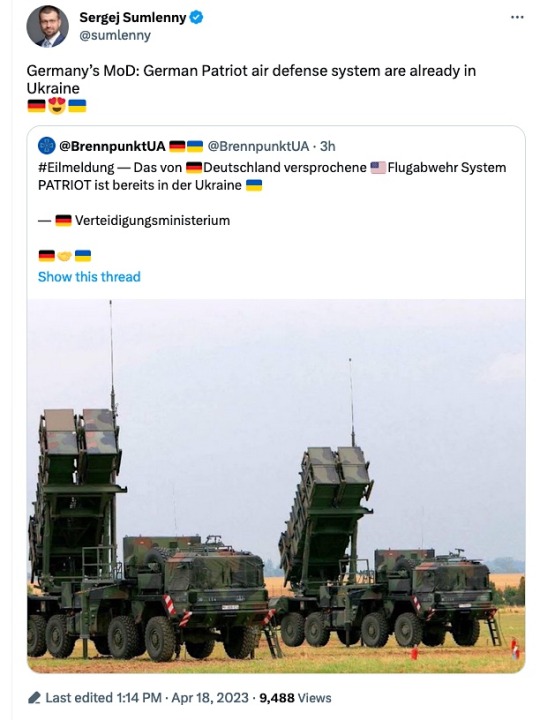
From @sumlenny
Germany’s Ministry of Defense has shipped US made PATRIOT air defense systems to Ukraine.
The mobile surface-to-air Patriot missiles are among the most advanced air defense systems available. Incoming cruise missiles, ballistic missiles, and military aircraft have all had their days ruined by Patriot missiles. Depending on the type of Patriot and its use, they can have a range of between 30 and 160 kilometers.
The ministry in its press release (in German) announced that Germany has also sent additional Zetros trucks and border patrol vehicles to Ukraine.
Russia must be defeated or it will just take a short rest and then do a repeat when it has replenished itself.
Russia is already in violation of three treaties plus the United Nations charter. It’s plain stupid to think that yet another treaty with Russia would mean “peace in our time”.
Retired US Army Gen. David Petraeus told Vazha Tavberidze at RFE/RL:
[T]his is very much an ongoing war, and it requires continued support, continued determination not just on the part of the Ukrainians but on the part of those who are helping them in what I think is about as clear a right-versus-wrong as we've seen in our lifetime: a dictatorial, kleptocratic regime denying the right of its neighbor to even exist, invading and doing so without provocation and in a particularly brutal manner, with a…culture of committing war crimes rather than preventing them and dealing with them when inevitably they might take place;
Agreed. As with World War II, there is no room for bothsiderism in this conflict. Just because Putin doesn’t have a silly mustache doesn’t mean he isn’t like Hitler.
#invasion of ukraine#patriot missiles#air defense#military aid for ukraine#germany#defeat russia#vladimir putin#russia's war of aggression#genocide#right-versus-wrong#david petraeus#tankies fuck off!#германия#ракетная система патриот#владимир путин#россия#агрессивная война россии#россия проигрывает войну#руки прочь от украины!#путин – это лжедмитрий iv а не пётр великий#союз постсоветских клептократических ватников#геноцид#путин - военный преступник#путин хуйло#геть з україни#вторгнення оркостану в україну#україна переможе#слава україні!#героям слава!
17 notes
·
View notes
Text
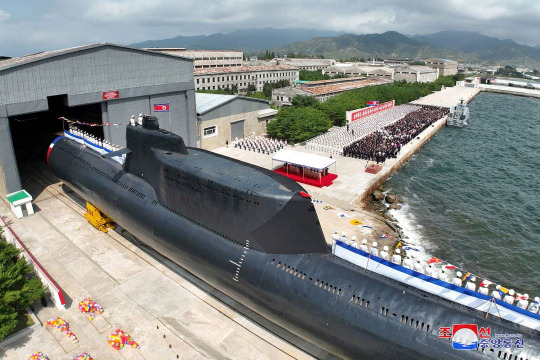

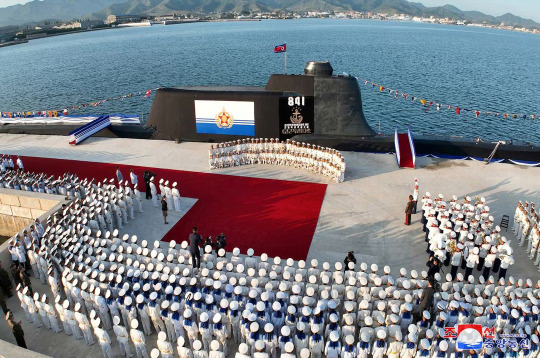





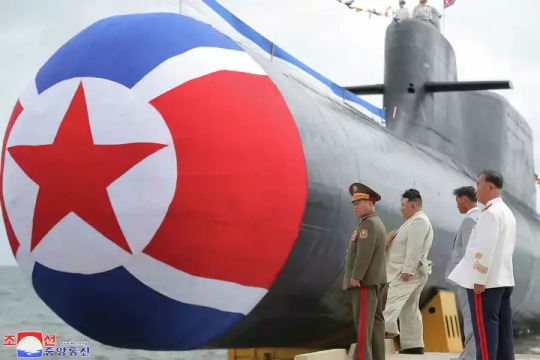

North Korea's new nuclear-armed, diesel-electric submarine, the Hero Kim Gun-Ok. A Romeo-class boat with a new central section housing short-range ballistic missiles and cruise missiles.
5 notes
·
View notes
Text
NATO defence ministers discussed boosting support for Ukraine and replenishing allies' depleted military stockpiles as they meet in Brussels starting on Wednesday.
"The message from NATO allies will be that we are steadfast in our support for Ukraine and that we are prepared for the long haul," NATO Secretary general Jens Stoltenberg told reporters upon arrival.
"We will discuss, address how to ramp up support for Ukraine," he said, stressing that "the top priority will be more air defence for Ukraine."
"We need different types of air defence, short-range, long-range air defence systems to take (out) ballistic missiles, cruise missiles, drones, different systems for different tasks," he added.
Russia targeted critical Ukraine's civilian infrastructure with a deadly wave of missile attacks, including in downtown Kyiv, on Monday, in retaliation for an explosion that damaged a bridge linking Russia to the illegally annexed peninsula of Crimea.
The missile attacks have been widely condemned by Western allies as war crimes.
Ukrainian forces are believed to have successfully knocked down a significant amount of the missiles that came their way but the attacks have seen them reiterate calls for more air defence assistance from allies.
Germany has already delivered four IRIS-Ts air defence systems while the US has pledged to send NASAMS systems. Other NATO members are expected to make similar announcements over the two-day summit.

Lethal weapons, artillery, armoured vehicles, and other anti-tank weapons are also on Ukraine's wish list, in particular mounted rocket launchers such as the 18 CAESAR self-propelled howitzers it has received from France or the HIMARS from the US which have been key to its recapture of territories from Russia.
Kyiv is also calling for allies to provide fuel, communication systems and winter equipment including clothing.
Oleksii Reznikov, Ukraine's defence minister, who is participating in the meeting of the Ukraine Defence Contact Group said he is "feeling optimistic."
Also on the agenda will be the alliance's own stocks.
"NATO recently held a meeting of armaments directors to come together and talk about ways that they could jointly address those declining stockpiles and ensure that production can be ramped up to meet the requirements not only of the Ukrainian forces that are fighting so courageously on the ground, but also of specific NATO allies," US ambassador to NATO Julianne Smith told Euronews on Tuesday evening.
"So this will be a focus of our work this fall well into the winter to see what we can do to close those gaps," she added.
Standardisation and interoperability — meaning ensuring the various kind of new equipment from the different allies can work together — will be a key focus for ministers.
They will also discuss protecting critical infrastructure after the sabotage of the Nord Stream pipelines late last month as well as the suspected sabotage of a German radio network last week.
"We have doubled our presence in the Baltic and North Seas to over 30 ships" that are "supported by maritime patrol aircraft and undersea capabilities," Stoltenberg has said.
But as most infrastructure is owned by private operators, ministers will need to start thinking about how best to assist them, boost surveillance and make better use of deterrence capabilities.
Nuclear deterrence will also be high on the agenda as NATO allies prepare to take part in their annual "Steadfast Noon" exercise next week despite the repeated nuclear threats from Russian President Vladimir Putin.
"Nuclear deterrence is a key feature of NATO's defence and deterrence posture. As such, the allies do conduct these types of exercises on a regular basis. And so this is not out of cycle. It is not in response to what's happening in Ukraine. This is something that NATO's would be doing irrespective of what's happening on the ground inside Ukraine," Smith said.
"What we know is that there's a lot of loose talk right now about the use of Russia's nuclear arsenal. We obviously find this kind of talk deeply disturbing and dangerous," she said, adding that they had informed the Russians "quite directly that any use of nuclear weapons would be faced with unprecedented consequences."
The drills which involve training flights with dual-capable fighter jets, as well as conventional jets, backed by surveillance and refuelling aircraft, are intended to ensure that NATO’s nuclear deterrent remains safe, secure and effective.
France, the UK and the US are the only NATO members to have nuclear weapons and some 100 US nuclear warheads are estimated to be stored across Europe, and thought to be in Belgium, Germany, Italy, the Netherlands and Turkey.
France also announced on Tuesday that it was upping its deterrence contribution on the alliance's eastern flank.
The country will add 200 troops to the 500 it has already deployed to Romania where it leads a multinational battlegroup as well as armoured fighting vehicles including tanks. Rafale fighter jets will be deployed to Lithuania to patrol while a light infantry company is to be dispatched to Estonia.
Romania President Klaus Iohannis described the announcement as "an important gesture for NATO's Eastern flank, a sign of solidarity between the Allies", while his Lithuanian counterpart, Gitanas Nausėda, said it represents "a strong signal of unity & solidarity against Russian aggression in Ukraine."
5 notes
·
View notes
Video
youtube
NASAMS: Ukraine's new weapons system explained
Forces News
Ukraine is set to receive a new weapons system in its conflict with Russia – the Norwegian Advanced Surface-to-Air Missile Systems or NASAMS. Designed to provide medium to long-range air defence against aircraft, cruise missiles or drones, NASAMS can fire short-range AIM-9X Sidewinder missiles plus the medium-range AIM-120 – identical to the missiles used on fighter aircraft. The weapons system is the same one used to defend the White House and Capitol Building in the US(..)
P.S. Although late, but overall very good news! However, Ukraine should have received modern NATO standard medium anti-aircraft missile systems much earlier and in much larger numbers!
#Ukraine#russian invasion#russian defeat#NASAMS#surface-to-air missile#defense of europe#defense of freedom#Norway#USA#very good news
4 notes
·
View notes
Text
North Korea launched several short-range ballistic missiles
North Korea launched several suspected short-range ballistic missiles toward its eastern waters, according to Asian media.
South Korea’s Joint Chiefs of Staff stated on Monday that it detected the launches from North Korea’s capital region, but did not provide any additional details. The report added that South Korea had reinforced its surveillance and maintained a firm readiness in close co-operation with the United States and Japan.
Japan also confirmed the launches, with Prime Minister Fumio Kishida’s office instructing officials to maximise efforts at gathering information and ensuring the safety of aircraft and ships, according to a statement released on X.
North Korea maintained an accelerated pace of weapons tests in recent months as it continued to expand its military capabilities amid tensions with the US and South Korea.
Kim Jong Un’s country announced on Saturday that it tested a “super-large” cruise missile warhead and a new anti-aircraft missile in the western coastal region on Friday.
Read more HERE
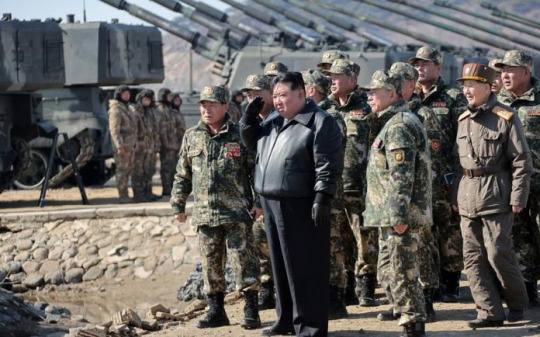
#world news#world politics#news#asia news#north korea#north korean#dprk#kim jong un#missile#ballistic missiles#japan#japanese news
0 notes
Text

UKRAINIAN AVENGER:
The ANTQ-1 'Avenger' provides mobile, Short-Range Air Defense (SHORAD) for Point Targets and Ground Units against Cruise Missiles, Unmanned Areal Vehicles UAVs, low-flying Fixed Wing and Rotary Wing Threats.
0 notes
Text

I flew the Danish F-35 Draken
Hush KitDecember 23, 2013
May 8, 2023
Dirk Reid swapped his RAF Tornado for a Saab Draken in the Royal Danish Air Force. Here he describes the excitement and idiosyncrasies of the fabulous F-35 Delta Dragon.
“It was a single-seat, single-engined aircraft, yet went for 13 years without any hull loss – compare that with Jaguars, Harriers and F-104s.
Draken in three words..
Quirky, innovative, versatile
What was the best thing about the Draken? Adaptability – our roles included recce, anti-shipping, EW, air-ground, other versions were capable air defenders in their time. And the radio, which had hundreds of pre-studded frequencies – just rotate one knob to find the airbase, then press the button marked ‘Radar’ for the radar frequency, the one marked ’Tower’ for the tower frequency etc etc
..and the worst? Being a double delta, it’s low-speed handling. In a stall, the rear section of the wing would lose lift first, whilst the forward part would continue flying, hence the nose came up. Then the forward part lost lift, so the nose would drop, until increased speed caused it (but not the rear part) to fly again, so the nose came up again….. This was called a super-stall, recovery required the stick to be pushed forwards as the nose came down, until both parts of the wing were creating lift, and then pulling out of the subsequent dive – if you had 10,000 ft to play with. Hence the front of the stick was fitted with the ‘knife’, a narrow blade of metal that, when the AoA, or onset of AoA was too high, rapidly vibrated against the pilots fingers causing a natural immediate releasing of the stick. Also, the fuel-state indications in the cockpit, which led directly to the first hull loss for many years. The SAAB designers were very good at taking human qualities into account when developing the aircraft, but this was a rare lapse.
What is the biggest myth about the aircraft? It’s short-field capability. Despite the parachute, landing at Rønne, Bornholm, which was 6,500ft long, needed you to get it on the numbers.
What was your first flight like? Such a long time ago! Thoroughly enjoyable I recall, but a blur of activity with plenty of fuel checks – I was used to turbofans, not a turbojet!
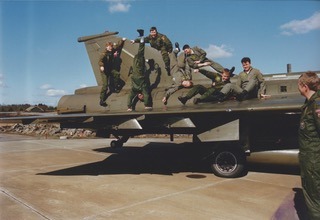
What was your most memorable experience flying the Draken? Probably the long-range recce missions into the far east of the Baltic. We’d launch from Karup and do a training mission on our way to Rønne, where a very lean support operation would give us fuel and a fresh parachute, which we’d have to re-fit into the aircraft. The recce from there was usually a hi-lo-hi profile, with a pair of F-16s as top cover to provide radio relay. We’d do as much as we could before pulling out on fuel minimums for the cruise home with the film for the eagerly-awaiting Photo Interpreters. If we got low on fuel, it was hard to resist the temptation to slow down, which had worked very well on my previous aircraft, but the double delta produced a max range speed of 450kts at low-level or 0.87M at height!
What was the role of the Draken and in which unit did you fly? It had many roles, but 729 Sqn was primarily a recce and anti-shipping outfit. We did a lot of ship recce in the Baltic, the cameras could be mounted to face forwards, sideways, down and rearwards, there was even a 42 inch sideways-facing lens that was very useful for peering deep inland. In the anti-shipping role we weren’t equipped with any guided missiles, so weren’t blue-water capable, more using rockets, bombs and bullets for opposing landing forces.
A. Instantaneous turn rates
Excellent for it’s generation, but no match for an F-16
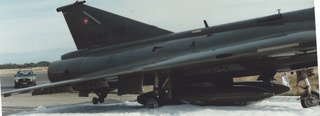
Sustained turn Needed the burners in! Incidentally, I was used to the Tornado, where the engine ran at max dry and the reheat was varied by the throttle once ‘through the gate’. In the Draken, the burner was on/off, and the engine speed was varied with the throttle
C. Climb rate Good for a mud-mover, but not equal to the fighter versions – we generally carried a lot under our wings.
D. General agility Not brilliant once the speed came off and the double delta started inducing drag.
E. High angle of attack performance See reference to the super stall above
F. Off-base operations Bread and butter to the Swedes, and designed into the airframe, but we never practised it.
G. As a fighter No radar in our version! We practised ACT and did well in a visual fight against older aircraft.
H. Sensors Day VFR only – we had a HUD for weapon aiming and a radalt and a laser to get the data into the weapon-aiming system – all our ordnance required visual acquisition of the target. Ironically, it had brilliant lighting for night close-formation flying, in stark contrast to my previous aircraft, the Tornado – supposedly designed for night flying!
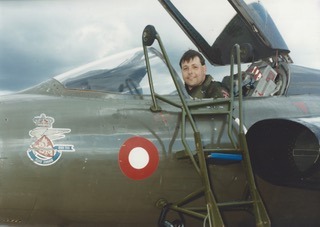
I. In terms of combat effectiveness and survivability? The aircraft was at the end of its life and we retired it from RDAF service when I was there. The Danish were very innovative in terms of the tactics they used, but ultimately the avionics fit limited its capability.
J. Cockpit layout and comfort? Of its day – a scattering of switches and instruments, with a mid-life update thrown in! It was also on the small side, not ideal for an ex prop forward. During landing, aerodynamic braking was normally used, with the aid of the fourth set of wheels in the tail, to slow the aircraft down. There was a radio transmit switch at the rear of the stick which could get involuntarily operated if an excessive belly got in the way, causing much embarrassment.
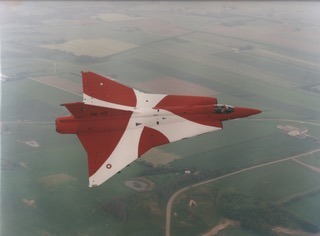
What should I have asked you? About the safety record. It was a single-seat, single-engined aircraft, yet went for 13 years without any hull loss – compare that with Jaguars, Harriers, F-104s etc.
Did the aircraft have a nickname? It’s called the “Dragon” – no need for a nickname!
Which weapons did you deploy and which was the most spectacular from the cockpit? US dumb bombs, CBUs, cannon and rockets – firing 2 full pods of 2.75 inch rockets was definitely one of my highlights!
Did you fly DACT against types and if so which types and which was the most challenging? Not really, plenty of low-level evasion against RDAF F-16s though.
Do you love the aircraft? Super-reliable and with some outlandish features – what’s not to like?
What was unusual about Danish air force tactics and culture? The culture was very different to the RAF, which consumed all and became a way of life. The RDAF was unionised, worked a set pattern of hours through the week and the workforce scattered to the four winds when the working day had finished. There was a very open and honest culture when it came to safety, which I am sure contributed to the impressive record alluded to earlier. Tactically, they were very free-thinking, willing to innovate and try new ideas.
Dirk Reid/Sqn Ldr/729 Sqn RDAF/1991- 94.
24 notes
·
View notes
Photo
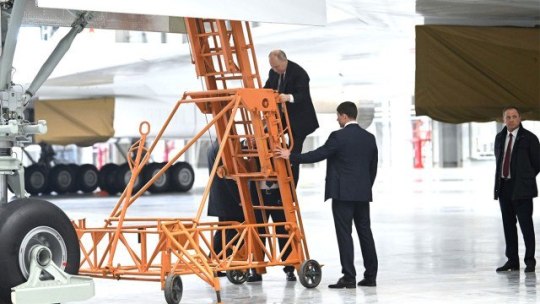
Putin Flies Supersonic Bomber During Tatarstan Visit
Russian President Vladimir Putin on Thursday flew a Tupolev Tu-160M strategic bomber, state-run news agencies reported, in what is likely a campaign stunt ahead of the March 15-17 presidential election.
The Tu-160M, a modernized version of a Cold War-era bomber, has two internal bomb bays, each of which can hold up to six cruise missiles or 12 short-range nuclear missiles.
Read more | Subscribe to our channel
0 notes
Text
Russia is continuing to leverage its relationship with Iran to obtain drones and missiles, likely to compensate for its increasingly attritted missile arsenal. The Washington Post reported on October 16 that Iran will likely supply additional missiles, including the Fateh-110 and Zolfaghar short-range ballistic missiles, to Russia in addition to Shahed-136, Mohajer-6, and Arash-2 drones. Iranian Foreign Ministry spokesperson Nasser Kanaani, however, claimed on October 17 that Iran has not provided weapons to “either side,” despite ample reporting by Russian, Iranian, Ukrainian, and Western sources to the contrary. A Russian Telegram channel noted that the recent Russian use of Iranian munitions, particularly the Shahed-136s, is likely reflective of the fact that Russia has nearly exhausted most of its domestic stock of operational-tactical weapons. The channel claimed that Shahed-136s fulfil the role of cruise missiles but allow Russia to circumvent sanctions while maintaining its ability to conduct deep operational strikes.
exhausting their stock of missiles doesn't mean much if they can still source them elsewhere, for now
20 notes
·
View notes
Text
Daily Wrap Up June 23, 2022
Under the cut: The European Union has approved the application of Ukraine [and Moldova] to become a candidate country for admission to the bloc; The UK government has issued an update to the list of goods that are banned from being exported to Russia; The United States will send another $450 million in military aid to Ukraine, including some additional medium-range rocket systems; The regional governor of the eastern region of Donetsk said on Thursday that no town is safe for residents as fighting between Russian and Ukrainian troops intensifies; Three cruise missiles hit southern Ukraine port city of Mykolaiv.
“The European Union has approved the application of Ukraine to become a candidate country for admission to the 27-strong bloc. EU leaders meeting in Brussels have followed the recommendation of the European Commission, which was made on Friday 17 June.
Ukraine has been seeking EU membership since the 2004 “orange revolution” and more emphatically since the 2013-14 Maidan protests. In the expectation of a positive outcome Ukraine’s President Volodymyr Zelenskiy had said: “This is like going into the light from the darkness.”
Ukraine’s ambassador to the EU, Vsevolod Chentsov, had said the move would mark “is a signal to Moscow that Ukraine, and also other countries from the former Soviet Union, cannot belong to the Russian spheres of influence.”
The move comes just one day short of the four month anniversary of Russian President Vladimir Putin ordering his troops into Ukraine for what Russia has insisted is not a war, but a “special military operation”.
The accession process to the EU can be lengthy. Until today the official list of candidate countries included Albania, the Republic of North Macedonia, Montenegro, Serbia and Turkey. Turkey gained candidate status in 1999, the Republic of North Macedonia in 2005.”
-via The Guardian
I did a longer write up of this here with more information about what this means and what the future could look like for Ukraine and proper EU status. Both Ukraine and Moldova have been granted candidacy status.
~
“The UK government has issued an update to the list of goods that are banned from being exported to Russia. The new details include:
Prohibitions on the export to, or for use in Russia of jet fuel and fuel additives.
Prohibitions on the export to, or for use in, Russia, of Sterling or EU denominated banknotes; as well as prohibitions on the making available, supply, or delivery of such banknotes to a person connected with Russia.
Prohibitions on the provision of technical assistance, financial services, funds, and brokering services relating to iron and steel imports.”
-via The Guardian
The official notice from the UK government can be found here.
~
“The United States will send another $450 million in military aid to Ukraine, including some additional medium-range rocket systems, to help push back Russian progress in the war, officials announced Thursday.
The latest package includes four High Mobility Artillery Rocket Systems, or HIMARS, which will double the number they have now. All four were prepositioned in Europe, and training on those systems has already begun with the Ukrainian troops who will use them, said Marine Corps Lt. Col. Anton Semelroth, a Pentagon spokesman. The first four HIMARS that the U.S. previously sent have already gone to the battlefield in Ukraine and are in the hands of troops there.
According to the Pentagon, the aid also includes 18 tactical vehicles that are used to tow howitzers, so the weapons can be moved around the battlefield, as well as 18 coastal and riverine patrol boats, thousands of machine guns, grenade launchers and rounds of ammunition, and some other equipment and spare parts.”-via AP
~
“The regional governor of the eastern region of Donetsk said on Thursday that no town is safe for residents as fighting between Russian and Ukrainian troops intensifies.
“There is no place, no town in Donetsk region where it would be safe,” Pavlo Kyrylenko told Agence France-Presse, citing latest intelligence data.
“It is extremely dangerous for residents to stay in any places of the region,” he added, given the current scale of fighting around the towns of Lysychansk and Severodonetsk.
Kyrylenko added that the priority was to prevent Russian forces from advancing into Slovyansk and Kramatosk some 80 kilometres away further west. He said around 45,000 people remained in the latter city - about one third of the pre-war population.
He also said that civilian evacuations were ongoing with 251 people taken out Wednesday from the area. According to him, deliveries of foodstuffs were continuing throughout the Donetsk region despite power outages and intermittent cuts to supplies of water and gas.”-via The Guardian
~
“Three cruise missiles hit Ukraine’s southern port city of Mykolaiv today, while air defences shot down another two missiles near the southern city of Odesa, the Ukrainian armed forces said in a statement.
Reuters reports that the military said one civilian was wounded in the strikes on Mykolaiv. The claims have not been independently verified.”-via The Guardian
8 notes
·
View notes
Text
Aselsan Debuts Gürz Short-range Air-defense (SHORAD) System at World Defence Show 2024
Aselsan's Gürz short-range air-defense (SHORAD) system made its international debut at the World Defense Show (WDS) 2024 in Riyadh, showcasing its formidable capabilities in intercepting aerial threats. Equipped with an array of advanced features, the Gürz is designed to effectively neutralize a wide range of targets, from unmanned aerial vehicles (UAVs) to cruise missiles, all from a single integrated platform that offers unparalleled flexibility and mobility. At the heart of the Gürz system lies its all-in-one design, which integrates multiple layers of defense into a single platform, providing a cost-effective and efficient solution for rapidly deploying and protecting critical assets.
Aselsan’s Gürz short-range air-defense (SHORAD) system made its international debut at the World Defense Show (WDS) 2024 in Riyadh, showcasing its formidable capabilities in intercepting aerial threats. Equipped with an array of advanced features, the Gürz is designed to effectively neutralize a wide range of targets, from unmanned aerial vehicles (UAVs) to cruise missiles, all from a single…

View On WordPress
0 notes